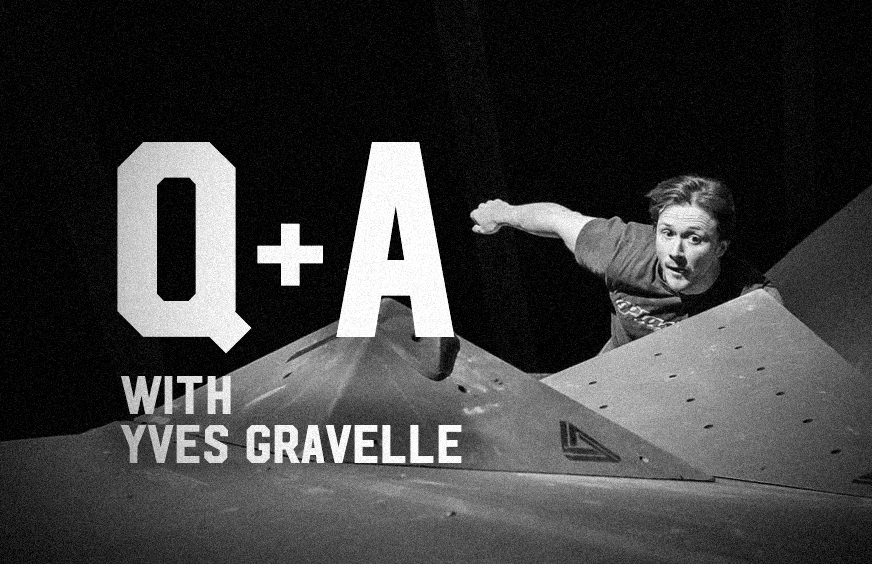
This week, we spoke with Yves Gravelle. He is recognized for his physical prowess in climbing and his finger strength, but also for the strength competitions in which he has been dominating in the past year.
1. WHAT IS YOUR BACKGROUND IN CLIMBING?
I’ve been climbing for over 20 years. I have spent several years participating in bouldering competitions and have had the opportunity to be part of the Canadian National Team several times. For the past few years, I have focused more on outdoor climbing, developing new bouldering sectors and making first ascents. I also coach the competitive team at Coyote Rock Gym.
2. HOW LONG HAVE YOU BEEN COMPETING IN STRENGTH COMPETITIONS?
Just over a year. I was fortunate to represent Canada at the World Championship in Russia last year where I won 3 gold medals and set 3 world records. In October, I participated in an International Arm lifting competition called the King Kong grip challenge. It’s a competition that takes place the same day in 25 sports sites on 4 continents. I finished first place in the -73kg category and received the distinction of the strongest fingers in the world relative to my weight.

3. WHAT IS YOUR TRAINING PHILOSOPHY?
I have always loved and put a particular emphasis on maximum strength, finger strength and body tension. I am very competitive with myself and I never set myself a limit in training. There is always room for improvement and a new personal best. That’s why I like training. It’s easy to measure progress and results.
4. WHAT IS YOUR POINT OF VIEW ON THE IMPACT OF GENETICS AND HARD WORK ON YOUR PERFORMANCE?
I’m not sure how much genetics played a role in my performance. One thing is certain, I worked very hard for my results. I am constantly looking for new training methods to improve myself.
5. WHAT ADVICE COULD YOU GIVE TO A CLIMBER WHO WANTS TO HAVE STRONGER FINGERS?
I think the most important thing is to vary the training, volume and intensity. It is important to do strength tests every 3-4 months in order to assess your progress and properly structure your training. For maximum strength and fingers I like to keep my workouts short. I always end up fresh and try to avoid high intensity training when I’m tired. I never train until exhaustion and I take full recoveries between sets (about 5 min). For example, if I can hold a crimp for a maximum of 10 seconds, I would do 4-6 seconds hangs during training.
In recent years, armlifting has greatly influenced my climbing training. I do a lot of deadlift style finger training. It allows me to structure the intensity more precisely and do repetitions similar to power lifting.
Here is an example of strength training for deadlift style fingers.
Week 1
1 Série x 6 repetitions @50% 1RM
1 Série x 6 repetitions @60% 1RM
1 Série x 6 repetitions @65% 1RM
4 series x 4 repetitions @70% 1RM
Week 2
1 Série x 6 repetitions @55% 1RM
1 Série x 6 repetitions @65% 1RM
1 Série x 6 repetitions @70% 1RM
4 Séries x 2 repetitions @80% 1RM
Week 3
1 Série x 6 repetitions @55% 1RM
1 Série x 6 repetitions @65% 1RM
1 Série x 6 repetitions @75% 1RM
4 Séries x 2 repetitions @85% 1RM
Week 4 (recovery week)
1 Série x 6 repetitions @50% 1RM
1 Série x 6 repetitions @60% 1RM
1 Série x 6 repetitions @65% 1RM
6. WHAT EQUIPMENT DO YOU USE AT HOME FOR YOUR TRAINING?
90% of my training is done at home. My favorite tools for climbing are the micro-rods and Digit’s V-Mobs, the Beastmaker 2000 beam and climbing on my side.
7. WHAT ACHIEVEMENT ARE YOU MOST PROUD OF?
My first ascent from Miall’s Ahead to Kanata -Tremblant is among the most memorable.
8. EVERYONE IS MAKING AN EFFORT THESE DAYS. WHAT IS YOUR “CHEAT-MEAL” DURING CONFINEMENT?
Ice Cream Sandwiches and Pretzels!
Yves often shares different challenges and trainings on his personal instagram account, if you’re interested!


